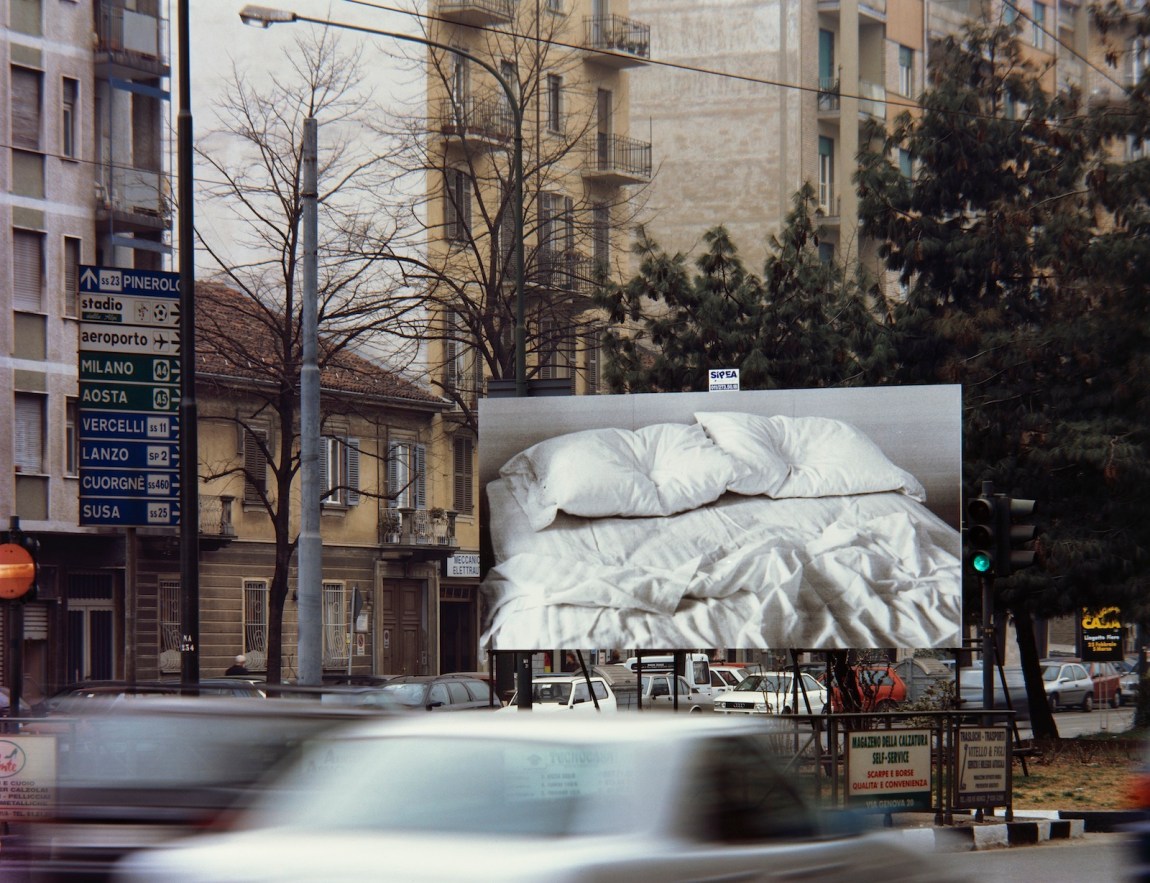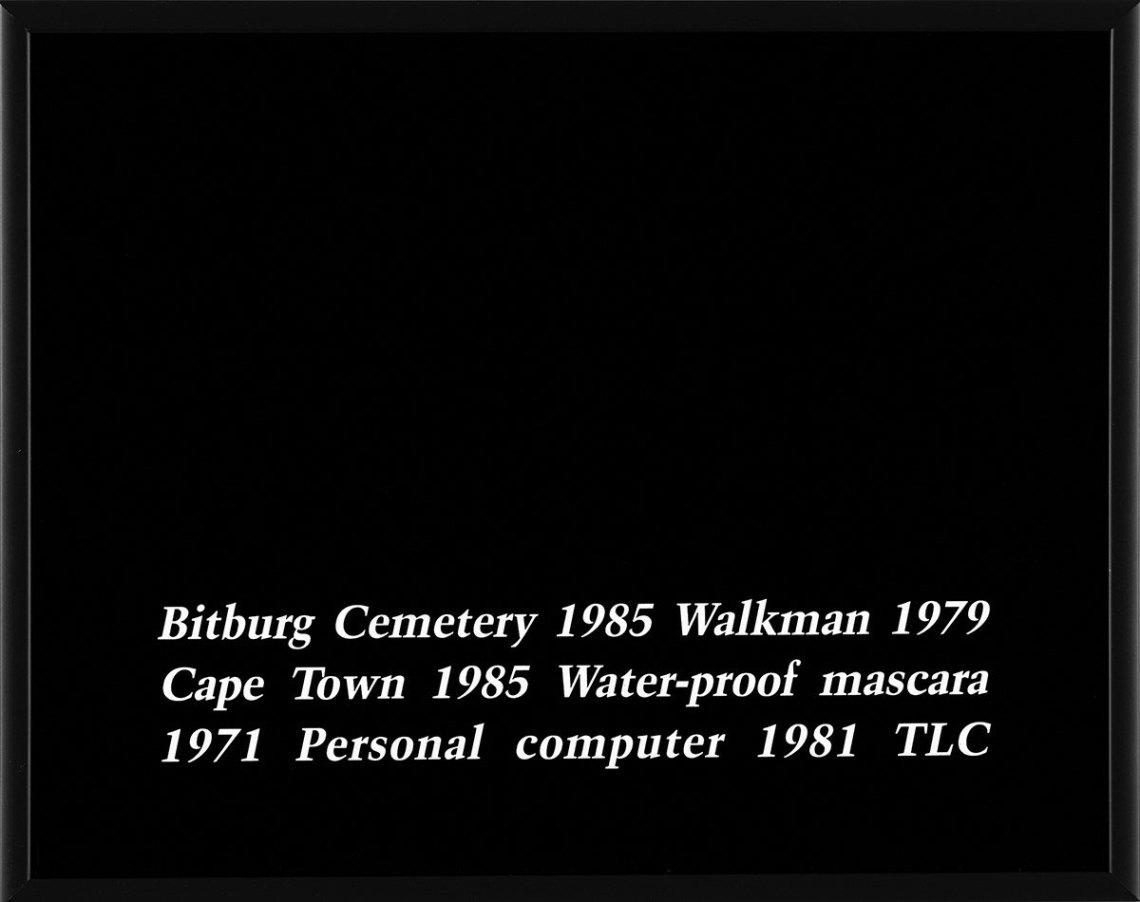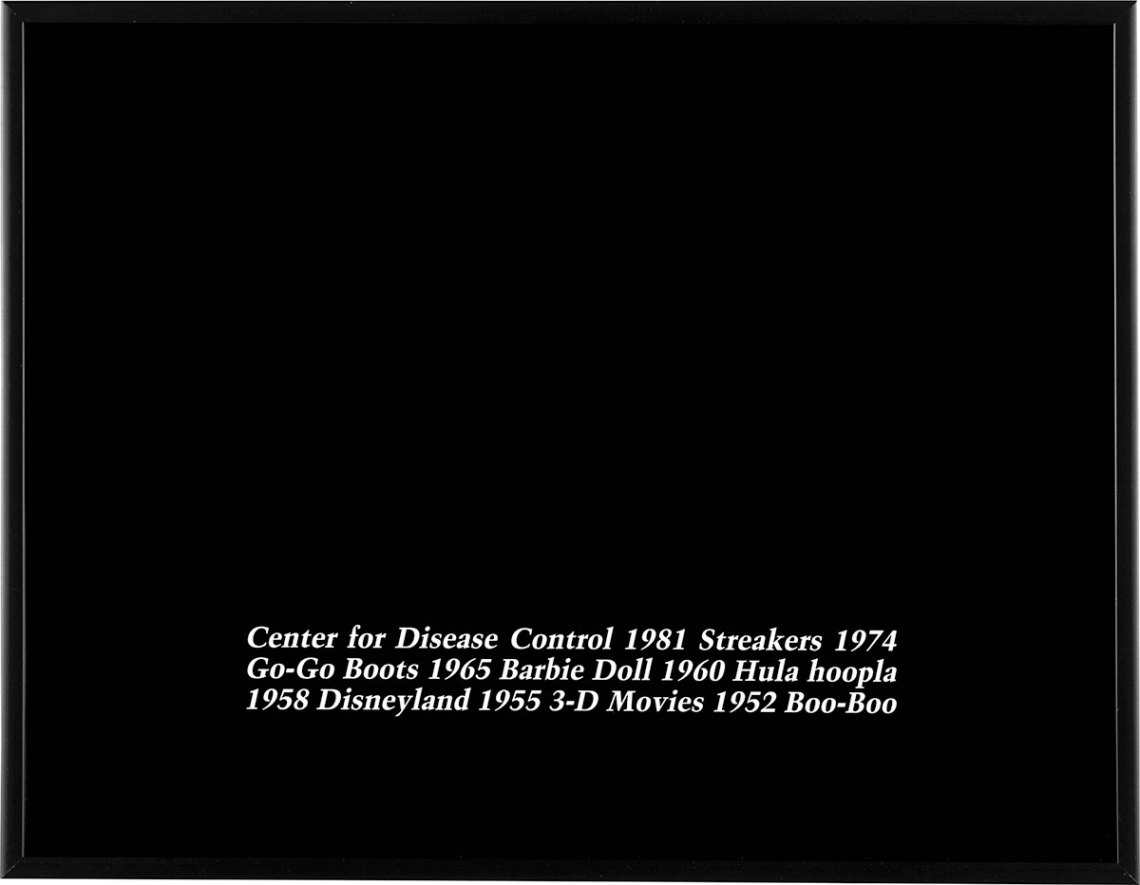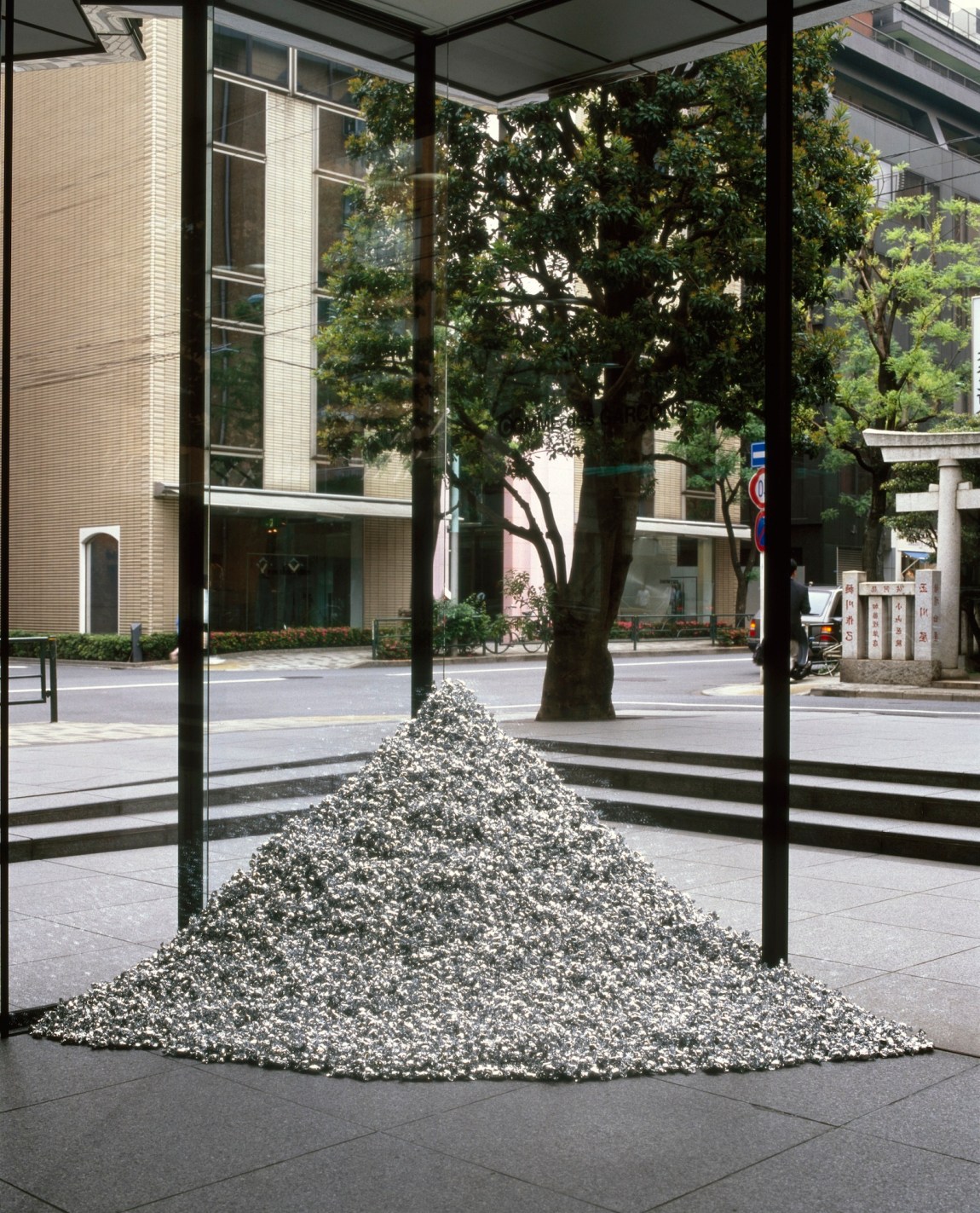Often, these days, when I’m in a museum or gallery, I find the artwork on offer surrounded by large helpings of didactic wall text telling me how to see what I’m seeing. At the time of the 2019 Venice Biennale, for example, the Palazzo Grassi hosted a Luc Tuymans exhibition in which painting after painting was accompanied by an explanatory narrative. The signage for Orchid, a strikingly green close-up of a flower, for some reason told viewers that “men’s semen is becoming less and less dense and fertile at a time when plants are modifying and enriching their sexual characters in order to adapt and survive….” The large and quite beautiful Still Life —apples and other fruit with a jug of clear water in the background—is dated 2002 and the curators wanted us to know that we aren’t just seeing fruit and water, that the work is actually “about the tragedy of 9/11.” Not directly, of course: the painting doesn’t respond to the terrorist attack “as such,” but instead “turns it toward the viewer in an interrogative, mysterious or alarming manner.” Then we’re told “the point” of the painting, that it’s “not to show the explosion, the two smashed buildings, or the bodies buried under the rubble, but what is left beyond good and bad, after the catastrophe, once the cloud of dust has settled.”
A passage in Walter Benjamin’s famous essay on art and mechanical reproduction made me wonder recently if the seed for the current kudzu of wall text hadn’t been planted late in the nineteenth century. In Benjamin’s telling, the rise of photography initiated a historic shift, the move away from religious or ceremonial art—works “destined to serve a cult”—to work made simply for exhibition. Photography at first carried forward some of art’s old values, the “cult of remembrance of loved ones,” but when the human face disappeared from photographs, the shift toward exhibition value became clear. Benjamin singles out Eugène Atget as the man who, around 1900, “pinpointed this new stage” by taking photographs of empty Paris streets. “It has quite justly been said of him that he photographed them like scenes of crime. The scene of a crime, too, is deserted; it is photographed for the purpose of establishing evidence.” Atget’s streets are not crime scenes, but how to make that clear? “Free-floating contemplation is not appropriate to them” and therefore “picture magazines begin to put up signposts” for the viewer. “For the first time, captions…become obligatory.” Captions are “directives”; they tell us how to see what we are seeing.
Early in his career, given the possible tension between images and texts, the American artist Felix Gonzalez-Torres (b. Cuba, 1957–1996) made a cunning move: he simply split the elements and made two kinds of art, captions without images and images without captions. The inspiration for that move may have come from the catalog for the Jewish Museum’s 1966 Ad Reinhardt retrospective, which included the artist’s own chronology of his life. Gonzalez-Torres never saw the show (he was a child in Cuba at that time), but he did eventually see the catalog and was taken with the way Reinhardt so thoroughly dispensed with the usual distinction between private life and public history:
1913 Born. New York, Christmas Eve. . .
1913 Malevich paints first geometric-abstract painting. . .
1915 Gets crayons for birthday, copies ‘funnies,’ Moon Mullins, Krazy Kat and Barney Google.
1916 Juan Gris paints “Dish of Fruit”. . .
1917 Cuts up newspapers. Tears pictures out of books.
1917 October Revolution in Russia. Lenin replaces Kerensky. . .
And so on up to the time of the exhibition:
1964 Ten paintings in London get marked up.
1964 China explodes atomic bomb.
1965 Man walks in space.
1966 One hundred twenty paintings at Jewish Museum.
Gonzalez-Torres understood this sort of chronology as a form of self-portraiture and—whether prompted by Reinhardt or not—it became his practice when making portraits to dispense with images and offer only “dateline” captions. In 1994, when Robert Vifian, a Vietnamese chef with a famous Paris restaurant, commissioned a portrait from Gonzalez-Torres, the result was a painted frieze circling the walls of a room, a running set of captions (supplied by both Vifian and the artist):
Agent Orange 1961
First T.V. 1966 7 p.m.
The Berlin Wall 1989
…and so on. In a letter to Vifian, Gonzalez-Torres explained his approach: “Photographs…can tell us almost anything (that is why captions are so important, not just for newspapers)…. I then, in these portraits, go the other way around.” Rather than offering an image supported by a caption, Gonzalez-Torres provides a series of captions, each one just a phrase or “coded word” for which the viewer must then provide the image.
Gonzalez-Torres had been making such dateline works since 1987, the early ones printed as black photostats with the captions in white type. The first of these begins “Bitburg Cemetery 1985,” a caption that for some people will call to mind an image of Ronald Reagan visiting a Nazi graveyard in Germany or perhaps of the protest signs that met him. If I myself am to provide the image, however, what comes to mind is a cat. My family has the habit of naming cats after historical events, and so, for many years, the veterinarian and everyone else knew the kitten we adopted in 1985 as Bitburg. As for the images that I might provide for the other caption fragments of Gonzalez-Torres’s Bitburg photostat, they end up forming an idiosyncratic Lewis Hyde self-portrait:
“Walkman 1979”: I see an artist friend who removed the guts of his Walkman and kept them in a plastic bag, all the colorful little wires and transistors.
“Cape Town 1985”: I see a still from a film about South Africa’s Truth and Reconciliation Commission, a hysterical woman being led from the courtroom.
“Water-proof mascara 1971”: I see a woman diving into a swimming pool.
“Personal computer 1981”: I see my late father at his desk.
“TLC”: I draw a blank! Maybe a bottle of hand lotion.
On the other side of Gonzalez-Torres’s division of text and image, we get photographs without any directive captions at all. To approach these reticent images, it helps to know about Gonzalez-Torres’s resistance to one strain of art-world identity politics. Rather than presenting himself overtly as a gay artist, Gonzalez-Torres preferred to work as a sort of secret agent in the house of culture. He found a remark he’d read by a right-wing activist inspiring. “I want to be invisible,” the man said. “I do guerilla warfare, I paint my face and travel at night. You don’t know it’s over until you are in the body bag. You don’t know until election night.” “This is good! This is brilliant!” said Gonzalez-Torres. “I want to be a spy, too. I want to be the one who resembles something else.” The puzzle then was how to make work that, in his words, was in some sense “about homosexual desire” but was nonetheless “inclusive” rather than oppositional. His solution was to move toward formalism, toward works that foreground the shape of things, leaving their content to be discovered. A formalist work doesn’t showcase its politics; its title can always be “Untitled.” Political fights “don’t come up in the same way if you are interested in beautiful abstractions.”
Formalist work is deadpan; it carries no directives, no reading instructions. Deadpan is cunning in this regard in that it places the burden of interpretation on the audience. Gonzalez-Torres was working in the 1980s and 1990s when public funding of the arts was under attack from conservative legislators, and he was amused to think of the quandary his work might present to those culture warriors. Were a congressman to come to the Hirshhorn Museum in Washington, D.C. and find that the government had supported an artist who hung two wall clocks next to each other, it would be hard for the politician to attack the work as homosexual art unless he were willing to share the fantasy life that had led him to that conclusion.
One of Gonzalez-Torres’s better-known captionless photographs shows the rumpled white sheets and the head-dented pillows of an empty double bed. The image was originally displayed in 1992 on twenty-four billboards scattered around the city of New York. The bed belonged to the artist and, in the months following the AIDS death of his lover, Ross Laycock, he photographed it, prompted in part by a memory of lines from a Wallace Stevens poem that both men admired: “We made a dwelling in the evening air, / In which being there together is enough.”
“There are many ways to ‘read’ this image,” writes bell hooks in her essay on Gonzalez-Torres, adding that those who know the story will naturally find “the power and pleasure of love and loss, the anguish of grief.” As for those who know no such details, who stroll the streets of Manhattan and come across a bed on a billboard, the image is “to be entered not through empathy with the artist, but by way of one’s own relationship to….” To what? To a current hot love affair? To a desire for high-end cotton sheets? To a crime scene? Granted, an empty bed is not quite like one of Atget’s ambiguous deserted Paris streets, but still, as one curator tells us, “for Gonzalez-Torres, the bed suggests not only personal and social realities, but another reality, which is the law.” Much on his mind in those days was the 1986 Supreme Court decision upholding Georgia’s anti-sodomy law. Had those billboards been mounted in Atlanta in the 1980s, the double bed could plausibly have been taken for a crime scene.
Advertisement
The photo by itself asks for none of those readings, of course, nor did Gonzalez-Torres. As with most of his work, its title was “Untitled” and, when reproduced in books, the only other information added is “Billboard. Dimensions vary with installation.” And yet it’s worth noting that after bell hooks explains how the image can be read many ways, she herself can’t do it; imagining the “masses of viewers who saw this work” without knowing the backstory, she offers no speculative range of readings but quickly returns to “remembered grief.” This formalist may be reticent, but once his story gets into your head, it’s hard to get it out.
There’s another way that Gonzalez-Torres imagined himself as an artist, not just as a spy in the house of culture but as a virus in the body politic. He once told the conceptual artist Joseph Kosuth that he had no interest in working outside the structures of power. “No. I want to have power…. I want to be like a virus that belongs to the institution. All the ideological apparatuses are…replicating themselves, because that’s the way the culture works. So if I function as a virus, an imposter, an infiltrator, I will always replicate myself together with those institutions.” Similarly, in a 1994 conversation with curator Hans Ulrich Obrist: “the virus is our worst enemy, but should also be our model in terms of not being the opposition anymore, not being very easily defined, so that we can attach ourselves to institutions which are always going to be there.”
There’s a lot going on in these remarks. To begin with the literal, remember that Gonzalez-Torres worked during the height of the AIDS epidemic, that his lover died of the disease, and that he himself carried HIV. So, of course, literally, “the virus is our worst enemy,” as he says, though then he adds a “but” and pivots to his metaphorical “model.” If we stick to the literal, however, that “but” can also point to medical history, which teaches that not all viruses are bad (the benign cowpox virus, for example, provides immunity against the malignant smallpox virus), or evolutionary history, which has shown that we would not be who we are without some viral help. Recent genome science has proposed that many features of the human body arose through “horizontal gene transfer,” entire packets of DNA moving sideways from one organism into another, acquired, that is, not by inheritance but by infection. “Roughly 8 percent of the human genome consists of the remnants of retroviruses,” science writer David Quammen tells us. “We are at least one-twelfth viral.”
Before any such historic virus benefits or any of the more present and common virus disasters can occur, the virus needs to find a way into the body and then, if it is to survive, to elude or suppress the immune system. HIV-1 became so literally deadly because it mastered both of those steps so well. As for a more metaphorical art virus, how might it get itself into the museums and galleries and how might it defeat their institutional defenses?
Gonzalez-Torres’s main suggestion is that viral works will do well to “look like something else.” He was always clear about his debts to and admiration for the minimalists who came before him. It isn’t hard to see a link between a Carl Andre floor covered with a layer of metal tiles and a Gonzalez-Torres floor covered with a layer of blue-and-white candies; or a link between Donald Judd’s aluminum boxes and Gonzalez-Torres’s neat rectangular stacks of printed paper. Judd’s boxes, of course, have no social agenda, hidden or otherwise, but Gonzalez-Torres’s paper stacks do, each piled sheet bearing an often politically suggestive text (as with one that simply declares “We Don’t Remember” in German: WIR ERINNERN UNS NICHT). The stacks “look so powerful,” says Gonzalez-Torres, “they look so clean…. But…when you get close to them you realize that they have been ‘contaminated’ with something social.”
Gonzalez-Torres also counted on the public’s acquisitiveness and sweet tooth to help give his work its viral spread. Why does anyone take one of his free printed works home? To share in its beauty, perhaps, but also just to have it, to own it. And a candy taken from the piles on offer to gallery patrons—a little sugar hit! The work may look minimalist but, in fact, it has what the minimalists typically resisted, a performative element. “I need the public to complete the work,” said Gonzalez-Torres. How do they do that? By accepting its free offerings, whereupon the “pieces just disperse themselves like a virus that goes to many different places—homes, studios, shops, bathrooms, whatever.” The candies are sweet treats, yes, but they are also viral packets.
How does the split between image and text, installation and explanation, play out in this viral framework? Gonzalez-Torres’s “Untitled” (Lover Boys), a pile of candies individually wrapped in silver cellophane, first appeared at the 1991 Whitney Biennial. The accompanying signage was decidedly reticent. What if it hadn’t been? Suppose there had been an explanatory notice of the sort I encountered at the Luc Tuymans exhibition:
“If I do a portrait of someone,” Felix Gonzalez-Torres has said, “I use their weight.” In this case, the pile of candy weighs about 355 pounds, the combined weights of the artist and his lover, Ross Laycock, now dead of AIDS. Visitors to the exhibition are invited to sample what the artist calls the “endless supply” of candy: “I’m giving you this sugary thing,” he has said. “You put it in your mouth and you suck on someone else’s body . . . For just a few seconds, I have put something sweet in someone’s mouth and that is very sexy.” Gonzalez-Torres has also described the work as “very masochistic” in that it symbolically invites the public to eat away at the Lover Boys’ bodies and in so doing to play the role of the AIDS virus which has already destroyed the body of Ross Laycock and promises to do the same to the artist. The candy in this case represents the virus itself and, in satisfying a hunger for something sweet and intimate, the public becomes the disease vector, acquiring an infection carried by sugar rather than by men’s semen.
I myself have enjoyed a sweet taken from one of Gonzalez-Torres’s candy spills, but I probably would have held back if something like that had met me on the gallery wall.
*
In his study of Japanese haiku, R.H. Blyth tells the story of a potter named Nonko, a masterful maker of black bowls used in tea ceremonies. Upon first glance, a bowl from Nonko’s shop would seem plain and unappealing, but, handled again and again over the years, its deep beauty would slowly appear. “The highest art of the artist is to hide rather than to reveal beauty,” Blyth concludes.
It was the great wit of Gonzalez-Torres’s practice to bring a comparable understanding to the political portion of his work. Since Duchamp, it has often been said that the audience completes the work of art. The twist here is that the audience cannot do that without at the same time risking being infected, as it were, by Gonzalez-Torres’s concerns. It took considerable spycraft and aesthetic savvy to make that transmission possible. Long before his interest in viral invisibility, Gonzalez-Torres had made the useful split between image and text—captions without images, images without directives—a move that continues to protect the work from having its “point” too readily declared. Not that it’s hard to find a point, but spectators must discover or create it for themselves. What they find will vary from person to person and from age to age, depending on whatever free associations, hungers, politics, and diseases are in the air. Meanwhile, the work sits there in silence, always untitled, always in endless supply.






